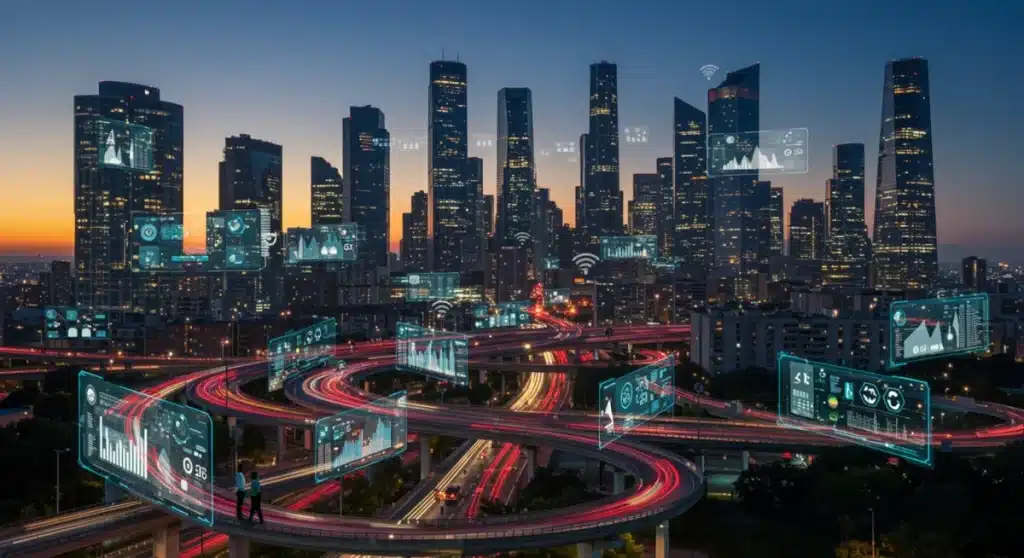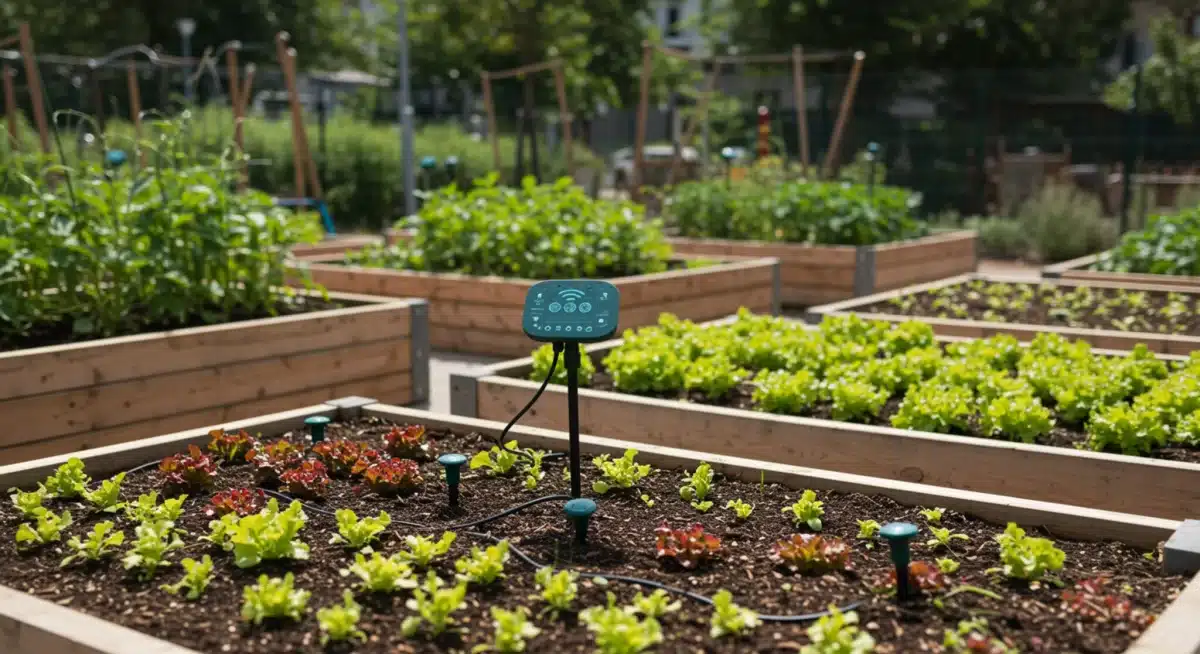US Smart City Initiatives: Data-Driven Innovation in Urban Life 2025

US Smart City Initiatives are fundamentally reshaping urban life by 2025, utilizing advanced data-driven innovation to create more efficient, sustainable, and responsive environments for residents across the nation.
The concept of the smart city has evolved from a futuristic ideal to a tangible reality, with US Smart City Initiatives leading the charge in transforming urban landscapes. By 2025, cities across the United States are increasingly leveraging data-driven innovation to enhance everything from public safety and transportation to environmental sustainability and citizen engagement. This evolution is not merely about integrating technology; it’s about creating more livable, efficient, and equitable urban environments for millions of residents. The promise of smart cities lies in their ability to harness vast amounts of data, converting it into actionable insights that optimize urban services and improve the overall quality of life.
The Foundation of Smart Cities: Data-Driven Governance
At the core of any successful smart city initiative is the intelligent utilization of data. This isn’t just about collecting information; it’s about establishing robust frameworks for data governance, ensuring privacy, security, and ethical use. By 2025, many US cities have recognized that effective data management is paramount to building trust and delivering impactful services.
Data-driven governance involves creating interconnected systems that gather information from various urban sensors, devices, and platforms. This raw data is then analyzed using artificial intelligence and machine learning to identify patterns, predict needs, and inform decision-making. The result is a more responsive and proactive city administration, capable of addressing challenges before they escalate.
Key Pillars of Data Governance in Smart Cities
- Data Privacy and Security: Implementing advanced encryption and anonymization techniques to protect citizen data.
- Interoperability Standards: Ensuring different city departments and technologies can seamlessly share and integrate data.
- Ethical AI Principles: Establishing guidelines for the fair and unbiased use of AI in urban planning and service delivery.
- Transparency and Accountability: Making data usage policies clear to the public and providing mechanisms for oversight.
The success of these initiatives hinges on a collaborative approach, involving city officials, technology providers, academic institutions, and the community. By fostering an ecosystem of innovation and trust, cities can unlock the full potential of data to serve their residents better. This foundational shift towards data-driven governance is setting the stage for more intelligent and resilient urban futures across the US.
Revolutionizing Urban Mobility with Intelligent Transportation Systems
One of the most visible impacts of US Smart City Initiatives by 2025 is the transformation of urban mobility. Congestion, pollution, and inefficient public transit have long plagued American cities. Data-driven intelligent transportation systems (ITS) are offering innovative solutions to these persistent challenges, making commutes smoother and more sustainable.
These systems leverage real-time data from traffic sensors, connected vehicles, public transit feeds, and even pedestrian movement to optimize traffic flow. AI algorithms can dynamically adjust traffic signals, reroute vehicles to less congested paths, and provide accurate, up-to-the-minute information to commuters. This not only reduces travel times but also minimizes fuel consumption and emissions.
Components of Advanced Intelligent Transportation
- Smart Traffic Signals: Adaptive signals that respond to real-time traffic conditions, reducing wait times at intersections.
- Connected Vehicle Technology: Vehicles that communicate with each other and with infrastructure to prevent accidents and optimize flow.
- Integrated Public Transit Systems: Real-time tracking and predictive analytics for buses, trains, and ride-sharing services to enhance efficiency and user experience.
- Smart Parking Solutions: Sensors and apps that guide drivers to available parking spots, reducing cruising and congestion.
Beyond efficiency, intelligent transportation systems are also enhancing safety. By identifying hazardous road conditions or potential accident hotspots, cities can deploy resources more effectively. The integration of various transport modes into a cohesive, data-driven network is not just improving individual journeys; it’s reimagining the entire fabric of urban movement, paving the way for more accessible and eco-friendly cities.
Enhancing Public Safety with Predictive Policing and Smart Surveillance
Public safety remains a top priority for urban centers, and US Smart City Initiatives are deploying advanced data-driven tools to create safer communities. By 2025, cities are moving beyond traditional policing methods, embracing predictive analytics and smart surveillance technologies to prevent crime and respond more effectively to emergencies.
Predictive policing models analyze historical crime data, social demographics, and environmental factors to identify areas and times with a higher likelihood of criminal activity. This allows law enforcement to allocate resources strategically, increasing police presence in vulnerable areas during critical periods. The goal is not to target individuals but to optimize resource deployment for crime prevention.

Smart surveillance, often integrated with public camera networks, uses AI-powered video analytics to detect unusual behavior, identify abandoned packages, or monitor large crowds. While raising privacy concerns, these systems are designed to enhance situational awareness for first responders, allowing for quicker intervention in emergencies. Implementing these technologies requires careful consideration of civil liberties and robust oversight mechanisms.
Technological Innovations in Public Safety
- AI-Powered Video Analytics: Automatically identifying anomalies or suspicious activities in public spaces.
- Gunshot Detection Systems: Sensors that pinpoint the location of gunshots, enabling rapid police response.
- Emergency Response Optimization: Using data to dispatch emergency services more efficiently, reducing response times.
- Community Engagement Platforms: Digital tools for citizens to report non-emergency issues and connect with local law enforcement.
The ethical deployment of these technologies is crucial, with ongoing debates about data retention, facial recognition, and the potential for bias. However, when implemented responsibly and transparently, data-driven public safety solutions hold immense potential to create more secure and resilient urban environments for all residents.
Driving Sustainability: Smart Energy Grids and Environmental Monitoring
As climate change impacts become more pronounced, US Smart City Initiatives are increasingly focused on environmental sustainability. By 2025, data-driven approaches are pivotal in managing energy consumption, reducing pollution, and fostering greener urban spaces. Smart energy grids and comprehensive environmental monitoring systems are at the forefront of these efforts.
Smart grids utilize sensors and advanced analytics to monitor energy demand and supply in real-time, optimizing distribution and reducing waste. This allows for better integration of renewable energy sources, such as solar and wind power, into the existing infrastructure. Citizens can also benefit from smart meters that provide detailed insights into their energy consumption, encouraging more efficient habits.
Environmental monitoring systems collect data on air quality, water purity, noise levels, and waste generation. This information helps city planners identify pollution hotspots, implement targeted interventions, and track the effectiveness of environmental policies. By making this data accessible, cities empower residents to make informed decisions and participate in sustainability efforts.
Smart Environmental Solutions
- Renewable Energy Integration: Seamlessly incorporating solar panels and wind turbines into the urban energy mix.
- Waste Management Optimization: Smart bins that signal when they are full, optimizing collection routes and reducing costs.
- Urban Green Space Management: Sensors monitoring soil moisture and plant health to optimize irrigation in parks and gardens.
- Air Quality Sensors: Networks of sensors providing granular data on pollutants, informing public health advisories.
These initiatives are not only about mitigating environmental damage but also about creating healthier and more resilient urban ecosystems. By harnessing data to manage natural resources more effectively, US smart cities are paving the way for a more sustainable future, demonstrating how technology can be a powerful ally in the fight against climate change.
Enhancing Citizen Engagement and Quality of Life through Digital Platforms
Beyond infrastructure and services, a key aspect of US Smart City Initiatives by 2025 is the profound impact on citizen engagement and overall quality of life. Data-driven digital platforms are bridging the gap between city administration and residents, fostering greater transparency, participation, and personalized urban experiences.
These platforms often take the form of integrated mobile applications or web portals that allow citizens to report issues (e.g., potholes, broken streetlights), access city services, provide feedback on urban projects, and receive real-time alerts. By centralizing these interactions and making them easily accessible, cities empower residents to become active participants in urban development.

Furthermore, data analytics can help cities understand citizen needs and preferences better, leading to the development of more relevant and impactful programs. For instance, data on park usage might inform decisions about new recreational facilities, while feedback on public transit routes could lead to service adjustments. The goal is to create a more responsive and citizen-centric urban environment.
Digital Tools for Citizen Empowerment
- 311-Style Reporting Apps: Streamlined systems for reporting non-emergency urban issues directly to city departments.
- Open Data Portals: Websites providing public access to city data, fostering transparency and encouraging civic innovation.
- Participatory Budgeting Platforms: Digital tools allowing residents to vote on how a portion of the city budget is spent.
- Personalized City Notifications: Opt-in alerts for local events, public safety warnings, or service disruptions tailored to individual interests and locations.
By fostering a more engaged and informed citizenry, smart city platforms are strengthening community ties and ensuring that urban development truly reflects the needs and aspirations of those who live there. This focus on improving quality of life through digital inclusion is a fundamental driver of smart city evolution.
Challenges and the Path Forward for Smart City Development
While the promise of US Smart City Initiatives is immense, their implementation is not without significant challenges. By 2025, cities are grappling with issues ranging from funding and technological integration to digital divides and public skepticism. Addressing these hurdles is crucial for the sustainable growth of smart urban environments.
One primary challenge is securing adequate funding. Smart city projects, especially those involving large-scale infrastructure upgrades, can be incredibly expensive. Cities often rely on a mix of federal grants, public-private partnerships, and innovative financing models. Another hurdle is the complexity of integrating disparate legacy systems with new smart technologies, requiring significant technical expertise and careful planning.
Moreover, the digital divide remains a concern. Not all citizens have equal access to technology or digital literacy, which can exacerbate existing inequalities if smart city services are not designed with inclusivity in mind. Public acceptance and trust are also vital, particularly regarding data privacy and surveillance technologies. Engaging communities early and transparently is essential to mitigate skepticism.
Overcoming Obstacles in Smart City Implementation
- Innovative Funding Models: Exploring public-private partnerships, bond issues, and federal grants to finance projects.
- Talent Development: Investing in local STEM education and training programs to build a skilled workforce for smart city operations.
- Digital Inclusion Programs: Providing affordable internet access and digital literacy training to underserved communities.
- Robust Cybersecurity Frameworks: Protecting critical infrastructure and sensitive data from cyber threats.
The path forward for US Smart City Initiatives involves continuous adaptation, learning from successes and failures, and prioritizing citizen needs. By embracing collaborative governance, fostering innovation, and addressing ethical considerations head-on, cities can navigate these challenges and build truly intelligent, resilient, and inclusive urban futures.
| Key Aspect | Impact by 2025 |
|---|---|
| Data Governance | Ensuring ethical data use, privacy, and security for urban services. |
| Urban Mobility | Reduced congestion and emissions through intelligent transportation systems. |
| Public Safety | Enhanced crime prevention and emergency response with predictive tools. |
| Sustainability | Greener cities via smart energy grids and environmental monitoring. |
Frequently Asked Questions About US Smart City Initiatives
By 2025, a ‘smart city’ in the US is defined by its strategic use of data-driven technologies and innovation to improve urban services, enhance sustainability, and elevate the quality of life for its residents. This includes intelligent transportation, smart grids, and citizen engagement platforms, all underpinned by robust data governance.
Smart cities leverage real-time data from sensors, connected vehicles, and public transit to optimize traffic flow, dynamically adjust signals, and provide commuters with accurate information. This reduces congestion, lowers emissions, and makes public transportation more efficient, leading to smoother and faster commutes for everyone.
Citizens benefit from smart city initiatives through improved public safety, more efficient transportation, better environmental quality, and enhanced access to city services. Digital platforms empower residents to engage with city governance, report issues, and receive personalized information, fostering a more connected community.
US smart cities face challenges such as securing funding for expensive projects, integrating diverse technologies, addressing the digital divide to ensure equitable access, and managing public concerns regarding data privacy and surveillance. Overcoming these requires collaborative governance and transparent communication.
Smart cities contribute to sustainability through optimized energy grids that integrate renewables, smart waste management systems, and comprehensive environmental monitoring. These initiatives reduce energy consumption, minimize pollution, and promote healthier urban ecosystems, helping cities combat climate change and conserve resources effectively.
Conclusion
The journey of US Smart City Initiatives by 2025 illustrates a profound commitment to leveraging data-driven innovation for the betterment of urban life. From intelligent transportation and enhanced public safety to robust sustainability efforts and empowered citizen engagement, these initiatives are fundamentally reshaping how American cities function and thrive. While challenges persist, particularly around funding, technological integration, and ethical data use, the collective vision remains clear: to build more resilient, efficient, and equitable urban environments. The continuous evolution of smart city strategies, informed by collaboration and a citizen-centric approach, promises a future where technology serves as a powerful catalyst for progress, ensuring that urban centers remain vibrant, livable spaces for generations to come.





